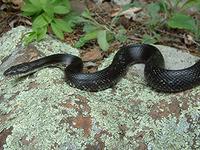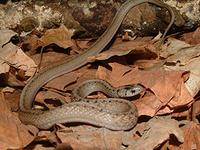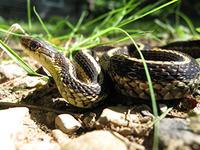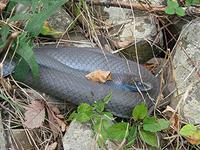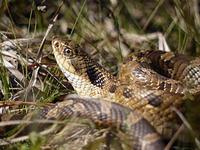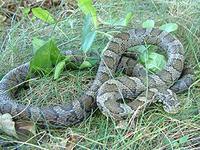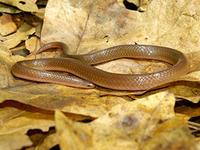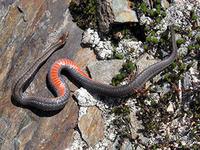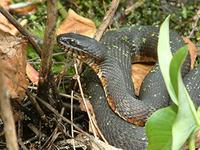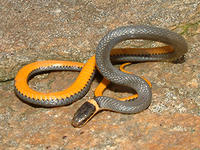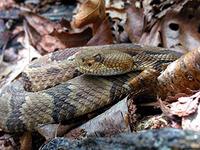Snake Species in Massachusetts
There are 14 species of snakes that call Massachusetts home. They come in many patterns and colors, and their diets and habitats vary.
Most species are non-venomous, including those most often found in yards or basements: the eastern garter snake and eastern milk snake. The two venomous species, the timber rattlesnake and northern copperhead, are very rare, and prefer rocky, forested hillsides. There are no water moccasins, cobras, or other exotic venomous snakes native to Massachusetts.
Black rat snake (Pantherophis alleghaniensis)
The largest snake in Massachusetts, the black rat snake grows up to 101”. It’s found in the Connecticut River Valley, and eats small mammals, birds, and amphibians. Adults are mostly black, with a white throat, and juveniles are mottled grey. Its scales are lightly keeled (they have a small ridge, as on the bottom of a boat).
Status
Endangered in Massachusetts, and, under the Massachusetts Endangered Species Act, it is illegal to kill, harass, or possess this snake.
DeKay’s brownsnake (Storeria dekayi)
Dekay’s brownsnake is often seen in urban and suburban areas, where it eats pests like slugs. It’s fairly small, between 9-13” long, and is skittish and shy. It is creamy beige-brown, with keeled scales, and dark brown spots down the back.
Eastern garter snake (Thamnophis sirtalis)
The eastern garter snake is one of our most commonly-seen snakes. It has long stripes down its body, but lacks the burgundy stripe and white eye spot of the rarer eastern ribbon snake. It eats amphibians, fish, small mammals, earthworms, and sometimes insects. People often mistakenly call this snake a “garden snake,” because it can sometimes be seen in gardens. However, the name “garter snake” comes from the old fashion of wearing garters—strips of fabric that held up stockings.
Eastern black racer (Coluber constrictor)
The eastern black racer grows fairly large, up to 73” long. Like the black rat snake, it is mostly black, but it has smooth scales. Young snakes are mottled grey-blue and brown. This snake may be more prone to striking if threatened, but this behavior is a bluff; it is non-venomous.
Eastern hognose snake (Heterodon platyrhinos)
This snake is named for its turned-up nose. Its body color varies from yellow to brown to black, and it has keeled scales. When threatened, this harmless snake may flatten its head like a cobra, and then play dead. Its diet is varied, but it prefers to eat toads.
Eastern milk snake (Lampropeltis triangulum)
The eastern milk snake has a mottled grey, brown, and reddish body. This non-venomous snake is often confused for a rattlesnake, but it lacks the rattle, keeled scales, and cat-like pupils. It’s found in fields, woodlands, rocky hillsides, and wetland edges, and primarily eats small mammals.
Eastern ribbon snake (Thamnophis sauritus)
Elegant and slender, the eastern ribbon snake has keeled scales. It looks much like an eastern garter snake, in that it has yellow and black stripes, but it also has thick burgundy stripes and a white mark by the eye. It lives in wetlands and eats amphibians, fish, and sometimes insects.
Eastern worm snake (Carphophis amoenus)
The eastern worm snake is smooth and pinkish-gray—much like a worm—and, in fact, earthworms are its main prey. It’s fairly small, usually measuring from 7-11” long. This species is found in the Connecticut River Valley.
Status
Threatened in Massachusetts, and, under the Massachusetts Endangered Species Act, it is illegal to kill, harass, or possess this snake.
Northern copperhead (Agkistrodon contortrix)
Venomous, the northern copperhead is extremely rare to encounter. It has a thick, heavy body, with keeled scales, a triangular head, and a thin, cat-like pupil. Its brown and orange body is well-camouflaged against the forest floor.
Status
Endangered in the Massachusetts, and, under the Massachusetts Endangered Species Act, it is illegal to kill, harass, or possess this snake.
Northern red-bellied snake (Storeria occipitomaculata)
Similar to the DeKay’s brownsnake, the northern red-bellied snake is small, with keeled scales and a brown back, and often eats slugs and worms. However, it’s generally less tolerant of urban and suburban areas than the brownsnake, and it has a bright red belly.
Northern water snake (Nerodia sipedon)
The northern water snake can grow fairly large, up to 55” long. It has heavily keeled scales, and a complex, varying pattern of browns, blacks, and grays. It’s found in wetlands—you may see it swimming—and it primarily eats amphibians and fish.
Ringneck snake (Diadophis punctatus)
The ringneck snake is named for the yellow ring around its neck. It’s typically found in moist wetlands, where it eats red-backed salamanders. This snake is slender and small, usually measuring from 10-15” long. It has smooth scales and a grey back.
Smooth greensnake (Opheodrys vernalis)
True to its name, the smooth greensnake is smooth and green. It prefers areas of thick foliage, where it can blend in. This gentle snake helpfully eats a number of insects, beetles, and other small creatures.
Timber rattlesnake (Crotalus horridus)
Venomous, the timber rattlesnake is extremely rare and localized. It has a heavy body, a triangular head, a slitted, cat-like pupil, and a rattle that it uses to warn potential predators. It prefers rocky, forested areas.
Status
Endangered in Massachusetts, and, under the Massachusetts Endangered Species Act, it is illegal to kill, harass, or possess this snake.


